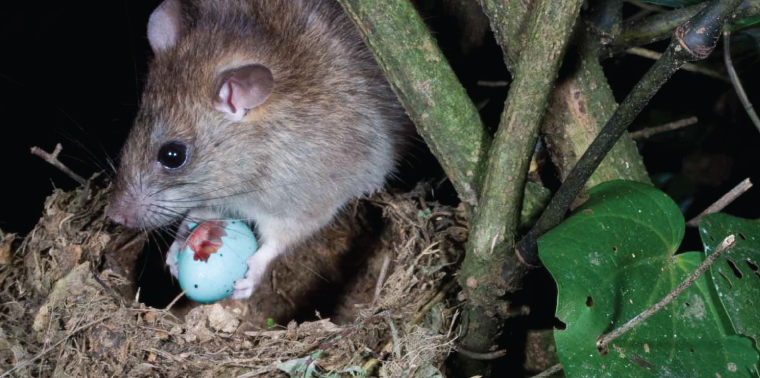January 13, 2014 — You’ve probably seen them on a nature documentary: those brown-blobs-of-shag-carpet birds that myopically wander around New Zealand on short, stocky legs, almost featureless except for long, narrow bills that they incessantly poke into the ground.
Kiwis may be the most adorable avians around, but they’re flightless. Cuteness is no protection against predatory stoats and feral cats, both of which were introduced to New Zealand by European colonists, and which have helped push many types of kiwi within a feather of extinction.
Human-introduced, invasive mammals — not just stoats and cats, but rats, ferrets, possums and many others — are a serious threat to New Zealand’s native birds, which, like many island species around the world, evolved in the absence of mammalian predators and are horribly under-equipped to defend themselves. Dozens of New Zealand species have become extinct since people began
settling there, and others survive only because conservationists fight invasive animals with guns, traps and poison in expensive, often endless campaigns that don’t always go according to plan: Sometimes animals that conservationists want to protect die after consuming toxic baits laid out If all goes to plan, invasive small mammals will be monitored and humanely killed like never before.for invasives, or suffer secondary poisoning from eating carcasses of target species that still have poison in their flesh. Nearly 50 bald eagles died on the Alaskan island of Hawadax, for example, after eating dead gulls that had fed on poisoned baits during a successful 2008 rat eradication effort.
Now, however, New Zealand’s indefatigable wildlife protectors have a promising new trick up their sleeves. They’re melding a range of innovative technologies into a potentially game-changing tool that might help kiwis — and eventually other threatened species around the world — survive. If all goes to plan, invasive small mammals will be monitored and humanely killed like never before.
The first of the new technologies is intended to replace the traditional method of using so-called tracking tunnels to confirm the presence of unwanted invasive mammals such as stoats (which can be shy and hard to see). Tracking tunnels are simple devices containing inked pads on either end of a piece of cardboard, baited to induce pests to leave telltale inky footprints behind. But conventional tracking tunnels often don’t work because the cardboard gets rained on, or so many animals walk across them that you can’t tell which species they are, or the invasive animals won’t go near them. They’re also pricey to deploy because they need to be laid out and maintained by competent operators, who need to be transported to often-remote survey areas and kept there, sometimes for weeks or months.
Helen Blackie, a wildlife researcher at New Zealand’s Lincoln University, figured there must be a better alternative to ink and cardboard. She approached Lincoln Agritech, a research and development company affiliated with the university, and together with the company’s engineers built a digital track plate that can capture images of the feet of small mammals that run across it and identify them to species level in a fraction of a second.
Blackie soon realized that the digital track plate could do more than just record the presence of invasive animals: when combined with other new pest-control innovations, it could be used to eradicate them without harming natives.

Using a digital trackplate, tasty bait, humane poison and discriminating delivery, Helen Blackie and collaborators have developed a novel device for dispatching predatory invasive mammals while protecting native species. Photo by Brent Barrett, Lincoln University.
One of these innovations (devised by other New Zealand researchers) is an almost irresistible bait that’s called “egg mayonnaise” because of its smell and appearance. The other is a new toxin called para-aminopropiophenone, or PAPP, which a New Zealand pest control products company called Connovation helped develop for pest control.
PAPP prevents red blood cells from releasing the oxygen they carry into vital organs, including the brain and heart. An animal that ingests a lethal dose of PAPP falls asleep and then quickly dies with minimal distress. If it ingests a sublethal dose, it goes to sleep and recovers apparently without adverse effects — PAPP breaks down to harmless compounds very quickly and doesn’t target nerves and organs like other poisons do. The quick breakdown makes secondary poisoning unlikely.
Unlike old paper-and-ink tracking tunnels, the digital track pad is weatherproof and doesn’t have to be checked or restocked daily. It can be left out in the field, powered by large batteries or the sun, potentially for years.
Blackie and her fellow innovators intend to use the digital track pad to control a new toxin delivery system called the Spitfire, which sprays a single dose of poison onto a target animal and then automatically resets, and is thus capable of numerous invasive animal kills over time. Because the track pad can identify species near-instantly, it will trigger the Spitfire only when target invasives are on it, sparing native species. Unlike old paper-and-ink tracking tunnels, the digital track pad is weatherproof and doesn’t have to be checked or restocked daily. It can be left out in the field, powered by large batteries or the sun, potentially for years.
Variations of the device could send text messages to tell researchers which species they’ve encountered and if they’re running low on poison, hugely reducing the cost of keeping nature reserves pest-free.
Blackie hopes to have the first, basic models of the digital track pad on the market a year from now. When that happens, kiwis and other threatened species should be able to breathe — and breed — a little easier. ![]()
Ensia shares solutions-focused stories free of charge through our online magazine and partner media. That means audiences around the world have ready access to stories that can — and do — help them shape a better future. If you value our work, please show your support today.
Yes, I'll support Ensia!

A fraction of concentration on the one species on this planet that needs to be controlled, would distract us from being so busy figuring out how to control/ kill everything else, wouldn't it?